Corporate Governance and Risk Management Analysis - TAB Bank
VerifiedAdded on 2021/06/15
|9
|2096
|25
Report
AI Summary
This report provides a comprehensive analysis of corporate governance and risk management issues at Terra Australis Bank (TAB). It begins by describing the actions taken by senior managers, highlighting their role in the financial planning scandal, including forging documents and manipulating client files for increased commissions and bonuses. The report then examines the concerning aspects of TAB's remuneration plan, which incentivized unethical behavior. It evaluates the actions taken by the Australian Securities and Investments Commission (ASIC) in response to the scandal, noting their slow initial response and the challenges they faced. The role of social media in exposing the fraud and promoting good governance is discussed, emphasizing its importance in bringing the issues to light. The report also emphasizes the importance of a robust whistle blower protection policy and the challenges faced by TAB in promoting ethical behavior. The analysis underscores the need for significant changes within TAB to regain customer trust and improve its corporate governance practices.
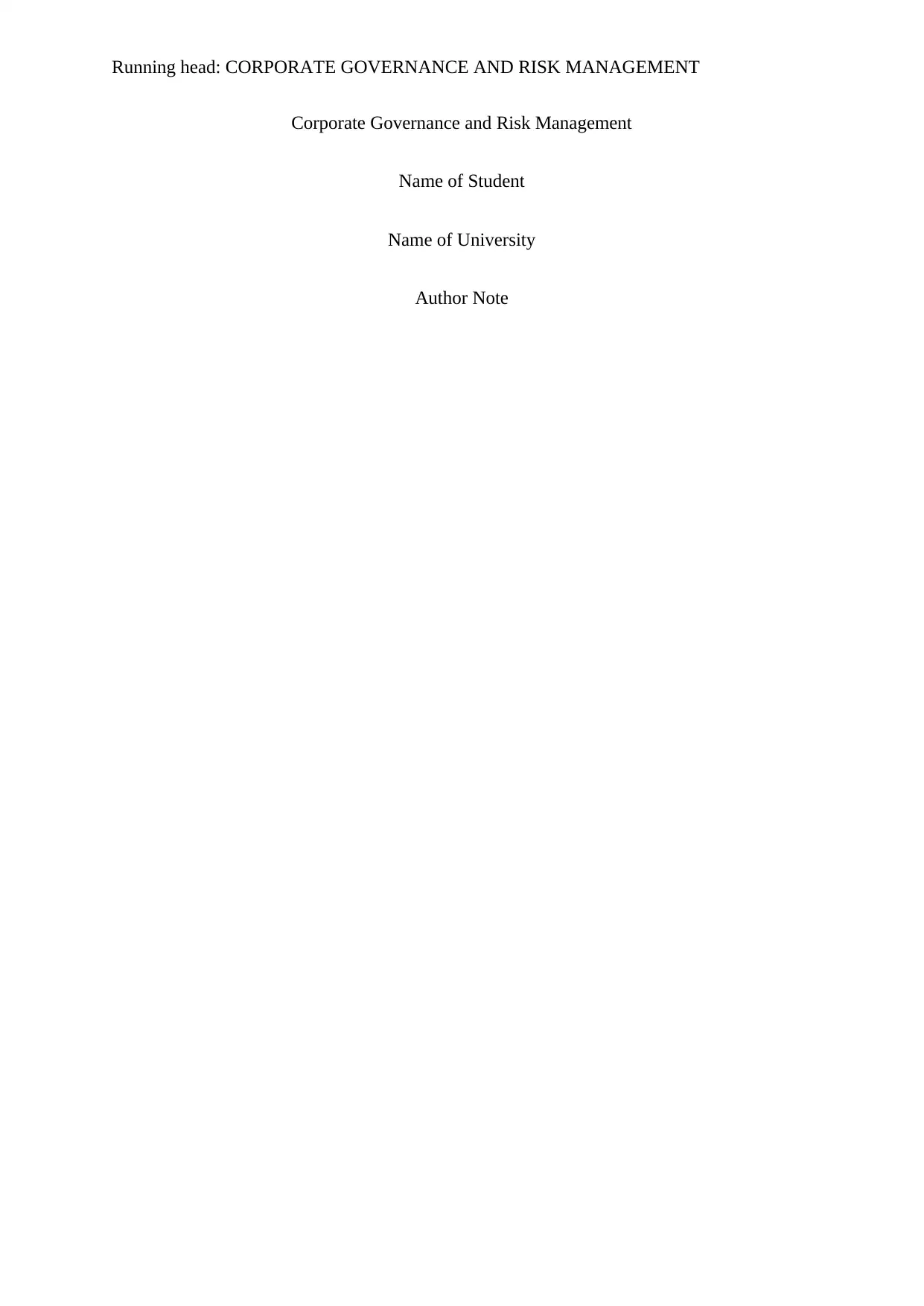
Running head: CORPORATE GOVERNANCE AND RISK MANAGEMENT
Corporate Governance and Risk Management
Name of Student
Name of University
Author Note
Corporate Governance and Risk Management
Name of Student
Name of University
Author Note
Paraphrase This Document
Need a fresh take? Get an instant paraphrase of this document with our AI Paraphraser
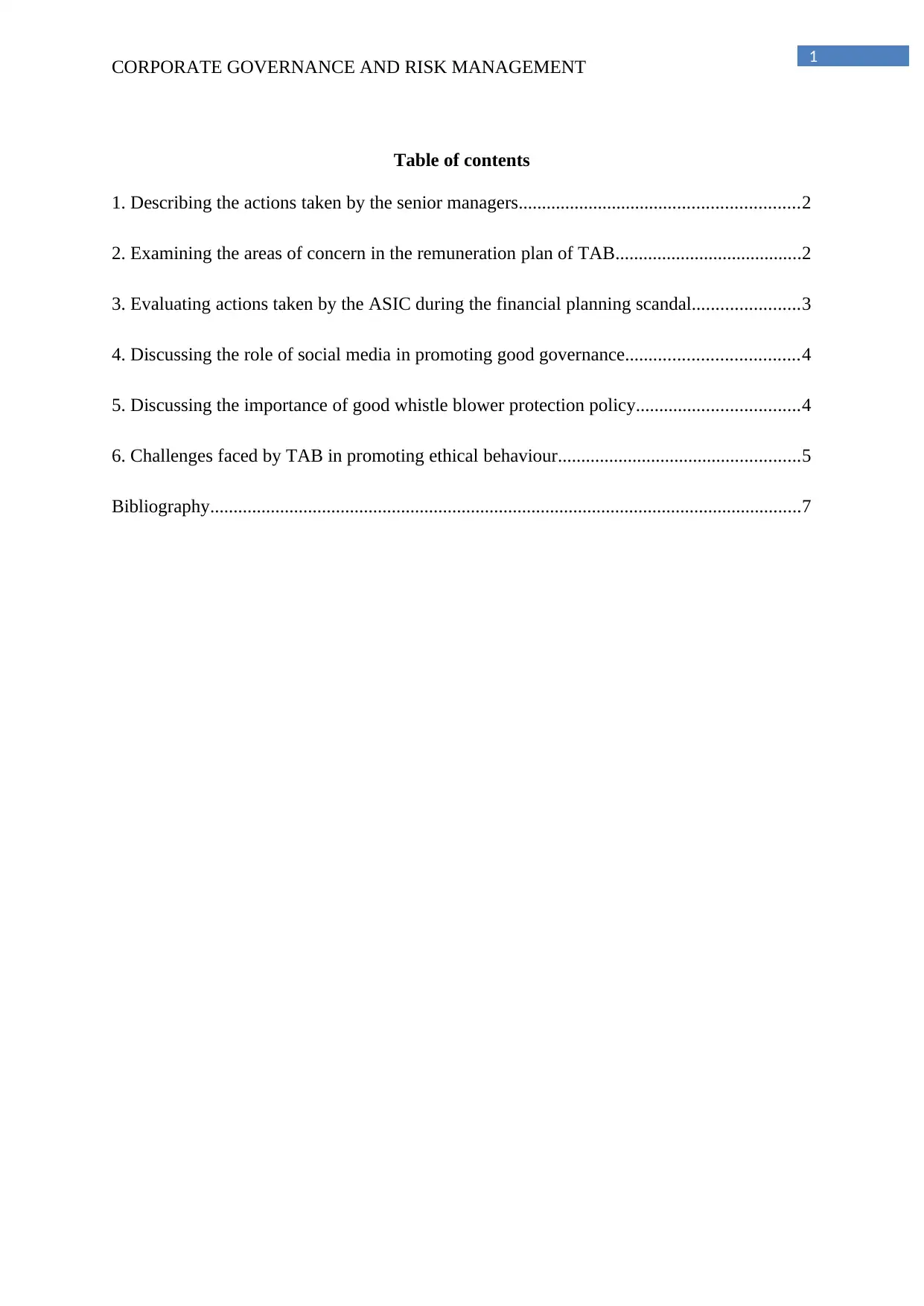
1
CORPORATE GOVERNANCE AND RISK MANAGEMENT
Table of contents
1. Describing the actions taken by the senior managers............................................................2
2. Examining the areas of concern in the remuneration plan of TAB........................................2
3. Evaluating actions taken by the ASIC during the financial planning scandal.......................3
4. Discussing the role of social media in promoting good governance.....................................4
5. Discussing the importance of good whistle blower protection policy...................................4
6. Challenges faced by TAB in promoting ethical behaviour....................................................5
Bibliography...............................................................................................................................7
CORPORATE GOVERNANCE AND RISK MANAGEMENT
Table of contents
1. Describing the actions taken by the senior managers............................................................2
2. Examining the areas of concern in the remuneration plan of TAB........................................2
3. Evaluating actions taken by the ASIC during the financial planning scandal.......................3
4. Discussing the role of social media in promoting good governance.....................................4
5. Discussing the importance of good whistle blower protection policy...................................4
6. Challenges faced by TAB in promoting ethical behaviour....................................................5
Bibliography...............................................................................................................................7
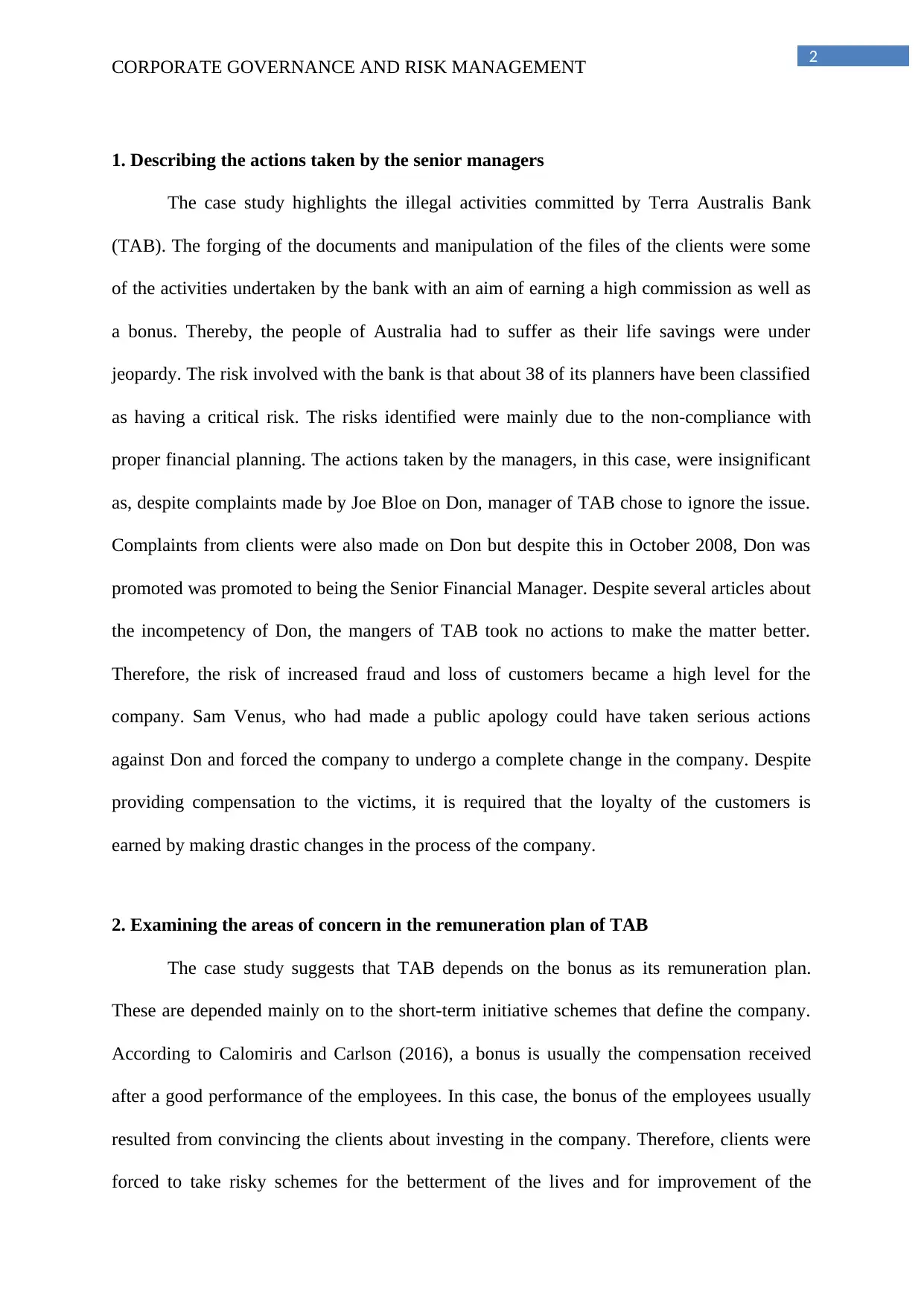
2
CORPORATE GOVERNANCE AND RISK MANAGEMENT
1. Describing the actions taken by the senior managers
The case study highlights the illegal activities committed by Terra Australis Bank
(TAB). The forging of the documents and manipulation of the files of the clients were some
of the activities undertaken by the bank with an aim of earning a high commission as well as
a bonus. Thereby, the people of Australia had to suffer as their life savings were under
jeopardy. The risk involved with the bank is that about 38 of its planners have been classified
as having a critical risk. The risks identified were mainly due to the non-compliance with
proper financial planning. The actions taken by the managers, in this case, were insignificant
as, despite complaints made by Joe Bloe on Don, manager of TAB chose to ignore the issue.
Complaints from clients were also made on Don but despite this in October 2008, Don was
promoted was promoted to being the Senior Financial Manager. Despite several articles about
the incompetency of Don, the mangers of TAB took no actions to make the matter better.
Therefore, the risk of increased fraud and loss of customers became a high level for the
company. Sam Venus, who had made a public apology could have taken serious actions
against Don and forced the company to undergo a complete change in the company. Despite
providing compensation to the victims, it is required that the loyalty of the customers is
earned by making drastic changes in the process of the company.
2. Examining the areas of concern in the remuneration plan of TAB
The case study suggests that TAB depends on the bonus as its remuneration plan.
These are depended mainly on to the short-term initiative schemes that define the company.
According to Calomiris and Carlson (2016), a bonus is usually the compensation received
after a good performance of the employees. In this case, the bonus of the employees usually
resulted from convincing the clients about investing in the company. Therefore, clients were
forced to take risky schemes for the betterment of the lives and for improvement of the
CORPORATE GOVERNANCE AND RISK MANAGEMENT
1. Describing the actions taken by the senior managers
The case study highlights the illegal activities committed by Terra Australis Bank
(TAB). The forging of the documents and manipulation of the files of the clients were some
of the activities undertaken by the bank with an aim of earning a high commission as well as
a bonus. Thereby, the people of Australia had to suffer as their life savings were under
jeopardy. The risk involved with the bank is that about 38 of its planners have been classified
as having a critical risk. The risks identified were mainly due to the non-compliance with
proper financial planning. The actions taken by the managers, in this case, were insignificant
as, despite complaints made by Joe Bloe on Don, manager of TAB chose to ignore the issue.
Complaints from clients were also made on Don but despite this in October 2008, Don was
promoted was promoted to being the Senior Financial Manager. Despite several articles about
the incompetency of Don, the mangers of TAB took no actions to make the matter better.
Therefore, the risk of increased fraud and loss of customers became a high level for the
company. Sam Venus, who had made a public apology could have taken serious actions
against Don and forced the company to undergo a complete change in the company. Despite
providing compensation to the victims, it is required that the loyalty of the customers is
earned by making drastic changes in the process of the company.
2. Examining the areas of concern in the remuneration plan of TAB
The case study suggests that TAB depends on the bonus as its remuneration plan.
These are depended mainly on to the short-term initiative schemes that define the company.
According to Calomiris and Carlson (2016), a bonus is usually the compensation received
after a good performance of the employees. In this case, the bonus of the employees usually
resulted from convincing the clients about investing in the company. Therefore, clients were
forced to take risky schemes for the betterment of the lives and for improvement of the
⊘ This is a preview!⊘
Do you want full access?
Subscribe today to unlock all pages.

Trusted by 1+ million students worldwide
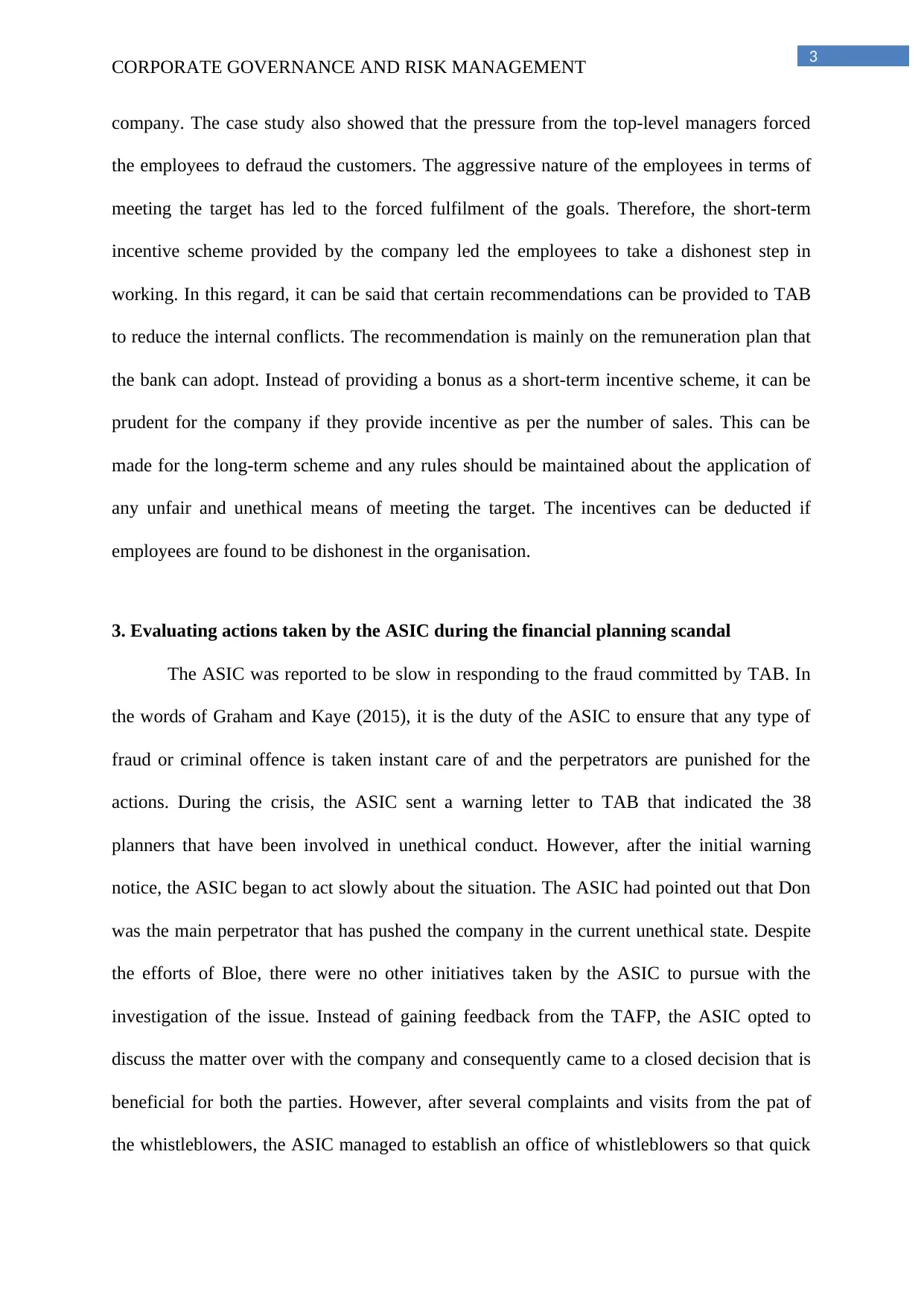
3
CORPORATE GOVERNANCE AND RISK MANAGEMENT
company. The case study also showed that the pressure from the top-level managers forced
the employees to defraud the customers. The aggressive nature of the employees in terms of
meeting the target has led to the forced fulfilment of the goals. Therefore, the short-term
incentive scheme provided by the company led the employees to take a dishonest step in
working. In this regard, it can be said that certain recommendations can be provided to TAB
to reduce the internal conflicts. The recommendation is mainly on the remuneration plan that
the bank can adopt. Instead of providing a bonus as a short-term incentive scheme, it can be
prudent for the company if they provide incentive as per the number of sales. This can be
made for the long-term scheme and any rules should be maintained about the application of
any unfair and unethical means of meeting the target. The incentives can be deducted if
employees are found to be dishonest in the organisation.
3. Evaluating actions taken by the ASIC during the financial planning scandal
The ASIC was reported to be slow in responding to the fraud committed by TAB. In
the words of Graham and Kaye (2015), it is the duty of the ASIC to ensure that any type of
fraud or criminal offence is taken instant care of and the perpetrators are punished for the
actions. During the crisis, the ASIC sent a warning letter to TAB that indicated the 38
planners that have been involved in unethical conduct. However, after the initial warning
notice, the ASIC began to act slowly about the situation. The ASIC had pointed out that Don
was the main perpetrator that has pushed the company in the current unethical state. Despite
the efforts of Bloe, there were no other initiatives taken by the ASIC to pursue with the
investigation of the issue. Instead of gaining feedback from the TAFP, the ASIC opted to
discuss the matter over with the company and consequently came to a closed decision that is
beneficial for both the parties. However, after several complaints and visits from the pat of
the whistleblowers, the ASIC managed to establish an office of whistleblowers so that quick
CORPORATE GOVERNANCE AND RISK MANAGEMENT
company. The case study also showed that the pressure from the top-level managers forced
the employees to defraud the customers. The aggressive nature of the employees in terms of
meeting the target has led to the forced fulfilment of the goals. Therefore, the short-term
incentive scheme provided by the company led the employees to take a dishonest step in
working. In this regard, it can be said that certain recommendations can be provided to TAB
to reduce the internal conflicts. The recommendation is mainly on the remuneration plan that
the bank can adopt. Instead of providing a bonus as a short-term incentive scheme, it can be
prudent for the company if they provide incentive as per the number of sales. This can be
made for the long-term scheme and any rules should be maintained about the application of
any unfair and unethical means of meeting the target. The incentives can be deducted if
employees are found to be dishonest in the organisation.
3. Evaluating actions taken by the ASIC during the financial planning scandal
The ASIC was reported to be slow in responding to the fraud committed by TAB. In
the words of Graham and Kaye (2015), it is the duty of the ASIC to ensure that any type of
fraud or criminal offence is taken instant care of and the perpetrators are punished for the
actions. During the crisis, the ASIC sent a warning letter to TAB that indicated the 38
planners that have been involved in unethical conduct. However, after the initial warning
notice, the ASIC began to act slowly about the situation. The ASIC had pointed out that Don
was the main perpetrator that has pushed the company in the current unethical state. Despite
the efforts of Bloe, there were no other initiatives taken by the ASIC to pursue with the
investigation of the issue. Instead of gaining feedback from the TAFP, the ASIC opted to
discuss the matter over with the company and consequently came to a closed decision that is
beneficial for both the parties. However, after several complaints and visits from the pat of
the whistleblowers, the ASIC managed to establish an office of whistleblowers so that quick
Paraphrase This Document
Need a fresh take? Get an instant paraphrase of this document with our AI Paraphraser
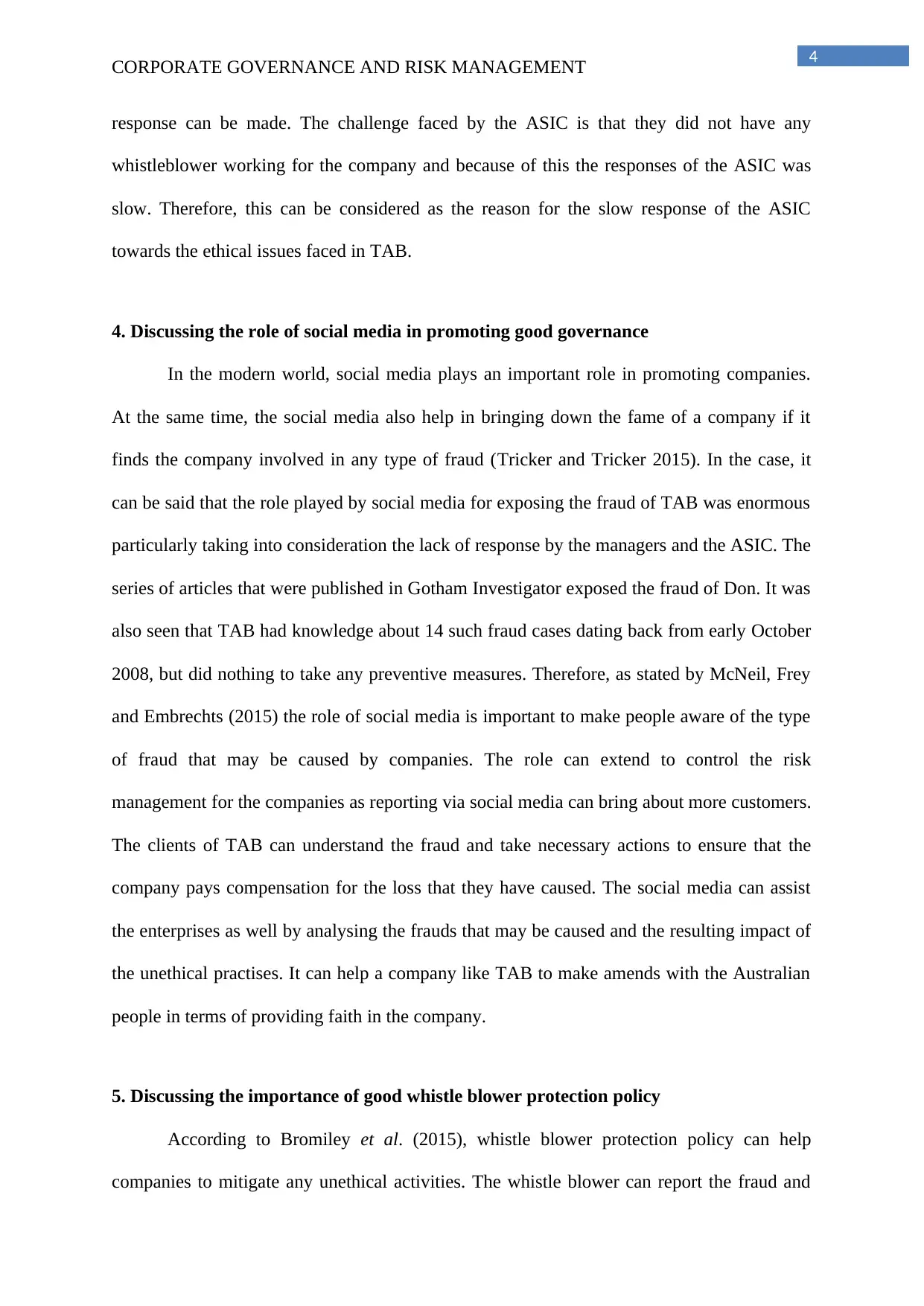
4
CORPORATE GOVERNANCE AND RISK MANAGEMENT
response can be made. The challenge faced by the ASIC is that they did not have any
whistleblower working for the company and because of this the responses of the ASIC was
slow. Therefore, this can be considered as the reason for the slow response of the ASIC
towards the ethical issues faced in TAB.
4. Discussing the role of social media in promoting good governance
In the modern world, social media plays an important role in promoting companies.
At the same time, the social media also help in bringing down the fame of a company if it
finds the company involved in any type of fraud (Tricker and Tricker 2015). In the case, it
can be said that the role played by social media for exposing the fraud of TAB was enormous
particularly taking into consideration the lack of response by the managers and the ASIC. The
series of articles that were published in Gotham Investigator exposed the fraud of Don. It was
also seen that TAB had knowledge about 14 such fraud cases dating back from early October
2008, but did nothing to take any preventive measures. Therefore, as stated by McNeil, Frey
and Embrechts (2015) the role of social media is important to make people aware of the type
of fraud that may be caused by companies. The role can extend to control the risk
management for the companies as reporting via social media can bring about more customers.
The clients of TAB can understand the fraud and take necessary actions to ensure that the
company pays compensation for the loss that they have caused. The social media can assist
the enterprises as well by analysing the frauds that may be caused and the resulting impact of
the unethical practises. It can help a company like TAB to make amends with the Australian
people in terms of providing faith in the company.
5. Discussing the importance of good whistle blower protection policy
According to Bromiley et al. (2015), whistle blower protection policy can help
companies to mitigate any unethical activities. The whistle blower can report the fraud and
CORPORATE GOVERNANCE AND RISK MANAGEMENT
response can be made. The challenge faced by the ASIC is that they did not have any
whistleblower working for the company and because of this the responses of the ASIC was
slow. Therefore, this can be considered as the reason for the slow response of the ASIC
towards the ethical issues faced in TAB.
4. Discussing the role of social media in promoting good governance
In the modern world, social media plays an important role in promoting companies.
At the same time, the social media also help in bringing down the fame of a company if it
finds the company involved in any type of fraud (Tricker and Tricker 2015). In the case, it
can be said that the role played by social media for exposing the fraud of TAB was enormous
particularly taking into consideration the lack of response by the managers and the ASIC. The
series of articles that were published in Gotham Investigator exposed the fraud of Don. It was
also seen that TAB had knowledge about 14 such fraud cases dating back from early October
2008, but did nothing to take any preventive measures. Therefore, as stated by McNeil, Frey
and Embrechts (2015) the role of social media is important to make people aware of the type
of fraud that may be caused by companies. The role can extend to control the risk
management for the companies as reporting via social media can bring about more customers.
The clients of TAB can understand the fraud and take necessary actions to ensure that the
company pays compensation for the loss that they have caused. The social media can assist
the enterprises as well by analysing the frauds that may be caused and the resulting impact of
the unethical practises. It can help a company like TAB to make amends with the Australian
people in terms of providing faith in the company.
5. Discussing the importance of good whistle blower protection policy
According to Bromiley et al. (2015), whistle blower protection policy can help
companies to mitigate any unethical activities. The whistle blower can report the fraud and
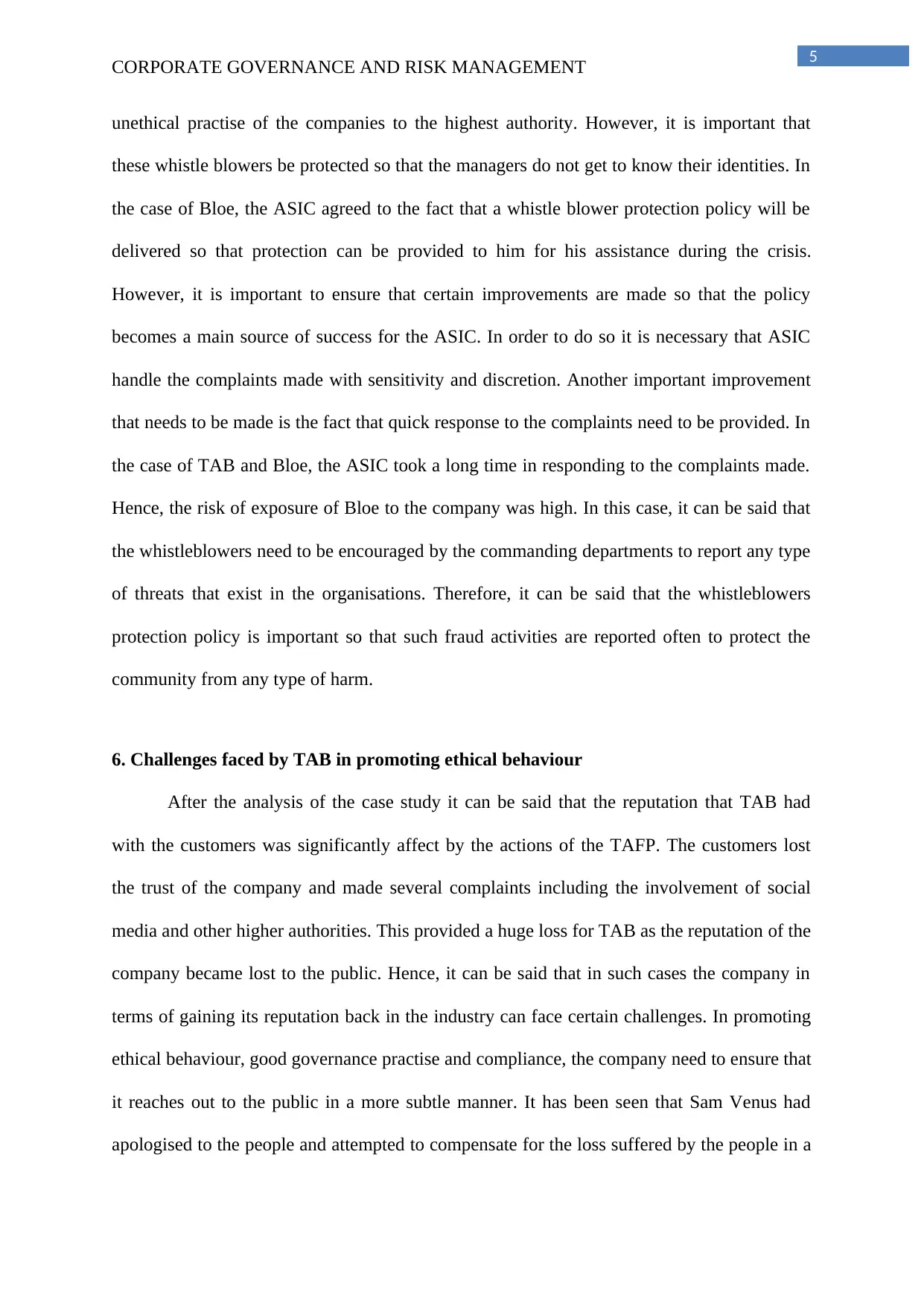
5
CORPORATE GOVERNANCE AND RISK MANAGEMENT
unethical practise of the companies to the highest authority. However, it is important that
these whistle blowers be protected so that the managers do not get to know their identities. In
the case of Bloe, the ASIC agreed to the fact that a whistle blower protection policy will be
delivered so that protection can be provided to him for his assistance during the crisis.
However, it is important to ensure that certain improvements are made so that the policy
becomes a main source of success for the ASIC. In order to do so it is necessary that ASIC
handle the complaints made with sensitivity and discretion. Another important improvement
that needs to be made is the fact that quick response to the complaints need to be provided. In
the case of TAB and Bloe, the ASIC took a long time in responding to the complaints made.
Hence, the risk of exposure of Bloe to the company was high. In this case, it can be said that
the whistleblowers need to be encouraged by the commanding departments to report any type
of threats that exist in the organisations. Therefore, it can be said that the whistleblowers
protection policy is important so that such fraud activities are reported often to protect the
community from any type of harm.
6. Challenges faced by TAB in promoting ethical behaviour
After the analysis of the case study it can be said that the reputation that TAB had
with the customers was significantly affect by the actions of the TAFP. The customers lost
the trust of the company and made several complaints including the involvement of social
media and other higher authorities. This provided a huge loss for TAB as the reputation of the
company became lost to the public. Hence, it can be said that in such cases the company in
terms of gaining its reputation back in the industry can face certain challenges. In promoting
ethical behaviour, good governance practise and compliance, the company need to ensure that
it reaches out to the public in a more subtle manner. It has been seen that Sam Venus had
apologised to the people and attempted to compensate for the loss suffered by the people in a
CORPORATE GOVERNANCE AND RISK MANAGEMENT
unethical practise of the companies to the highest authority. However, it is important that
these whistle blowers be protected so that the managers do not get to know their identities. In
the case of Bloe, the ASIC agreed to the fact that a whistle blower protection policy will be
delivered so that protection can be provided to him for his assistance during the crisis.
However, it is important to ensure that certain improvements are made so that the policy
becomes a main source of success for the ASIC. In order to do so it is necessary that ASIC
handle the complaints made with sensitivity and discretion. Another important improvement
that needs to be made is the fact that quick response to the complaints need to be provided. In
the case of TAB and Bloe, the ASIC took a long time in responding to the complaints made.
Hence, the risk of exposure of Bloe to the company was high. In this case, it can be said that
the whistleblowers need to be encouraged by the commanding departments to report any type
of threats that exist in the organisations. Therefore, it can be said that the whistleblowers
protection policy is important so that such fraud activities are reported often to protect the
community from any type of harm.
6. Challenges faced by TAB in promoting ethical behaviour
After the analysis of the case study it can be said that the reputation that TAB had
with the customers was significantly affect by the actions of the TAFP. The customers lost
the trust of the company and made several complaints including the involvement of social
media and other higher authorities. This provided a huge loss for TAB as the reputation of the
company became lost to the public. Hence, it can be said that in such cases the company in
terms of gaining its reputation back in the industry can face certain challenges. In promoting
ethical behaviour, good governance practise and compliance, the company need to ensure that
it reaches out to the public in a more subtle manner. It has been seen that Sam Venus had
apologised to the people and attempted to compensate for the loss suffered by the people in a
⊘ This is a preview!⊘
Do you want full access?
Subscribe today to unlock all pages.

Trusted by 1+ million students worldwide

6
CORPORATE GOVERNANCE AND RISK MANAGEMENT
public statement. This can be considered as small steps towards the progress of regaining the
reputation of the company. TAB need to ensure that the customers gain the trust of the
companies with the ethical considerations that are required for a financial company. The
money obtained illegally need to be returned so that the customers does not suffer from any
type of issues related to the company.
CORPORATE GOVERNANCE AND RISK MANAGEMENT
public statement. This can be considered as small steps towards the progress of regaining the
reputation of the company. TAB need to ensure that the customers gain the trust of the
companies with the ethical considerations that are required for a financial company. The
money obtained illegally need to be returned so that the customers does not suffer from any
type of issues related to the company.
Paraphrase This Document
Need a fresh take? Get an instant paraphrase of this document with our AI Paraphraser
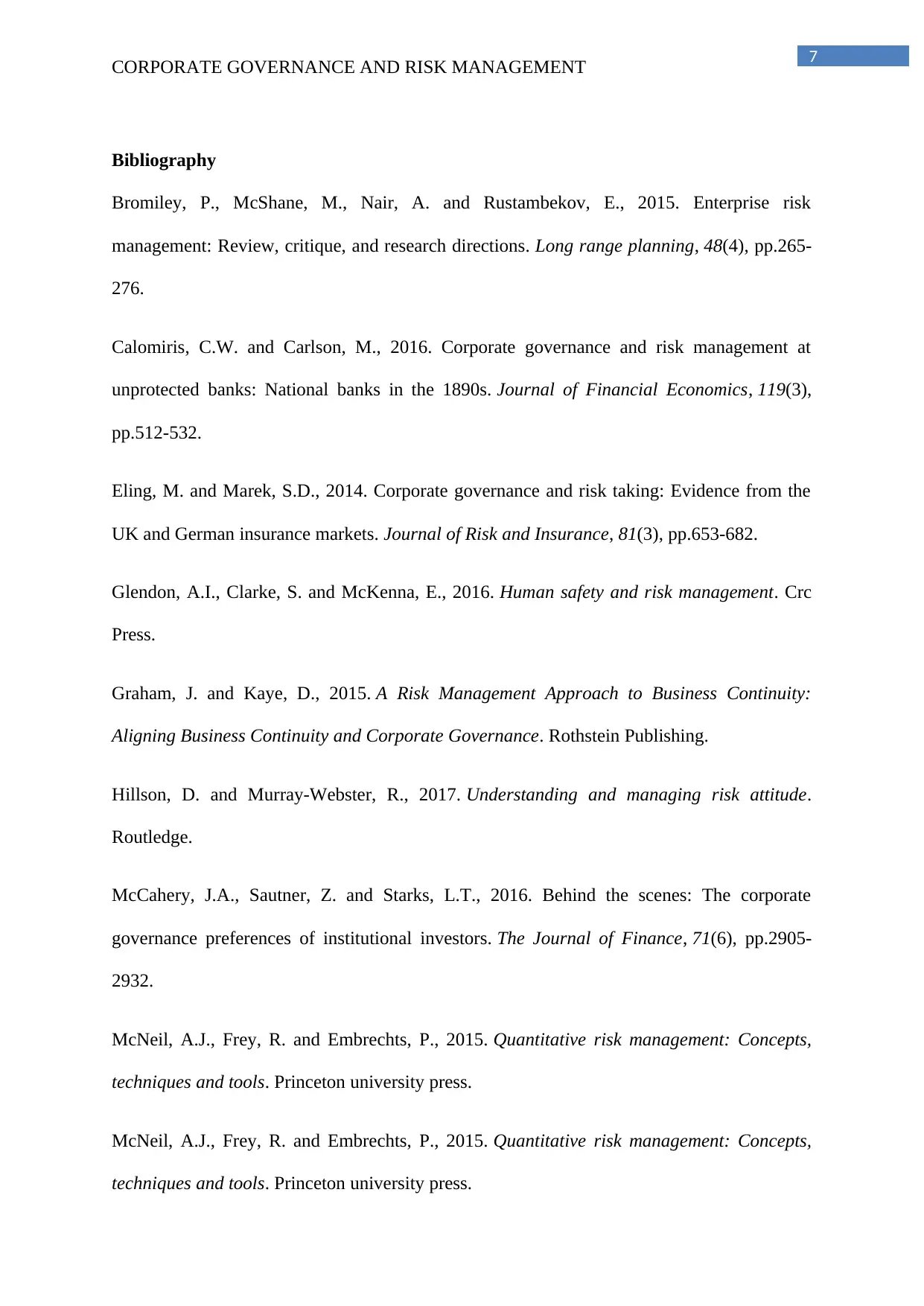
7
CORPORATE GOVERNANCE AND RISK MANAGEMENT
Bibliography
Bromiley, P., McShane, M., Nair, A. and Rustambekov, E., 2015. Enterprise risk
management: Review, critique, and research directions. Long range planning, 48(4), pp.265-
276.
Calomiris, C.W. and Carlson, M., 2016. Corporate governance and risk management at
unprotected banks: National banks in the 1890s. Journal of Financial Economics, 119(3),
pp.512-532.
Eling, M. and Marek, S.D., 2014. Corporate governance and risk taking: Evidence from the
UK and German insurance markets. Journal of Risk and Insurance, 81(3), pp.653-682.
Glendon, A.I., Clarke, S. and McKenna, E., 2016. Human safety and risk management. Crc
Press.
Graham, J. and Kaye, D., 2015. A Risk Management Approach to Business Continuity:
Aligning Business Continuity and Corporate Governance. Rothstein Publishing.
Hillson, D. and Murray-Webster, R., 2017. Understanding and managing risk attitude.
Routledge.
McCahery, J.A., Sautner, Z. and Starks, L.T., 2016. Behind the scenes: The corporate
governance preferences of institutional investors. The Journal of Finance, 71(6), pp.2905-
2932.
McNeil, A.J., Frey, R. and Embrechts, P., 2015. Quantitative risk management: Concepts,
techniques and tools. Princeton university press.
McNeil, A.J., Frey, R. and Embrechts, P., 2015. Quantitative risk management: Concepts,
techniques and tools. Princeton university press.
CORPORATE GOVERNANCE AND RISK MANAGEMENT
Bibliography
Bromiley, P., McShane, M., Nair, A. and Rustambekov, E., 2015. Enterprise risk
management: Review, critique, and research directions. Long range planning, 48(4), pp.265-
276.
Calomiris, C.W. and Carlson, M., 2016. Corporate governance and risk management at
unprotected banks: National banks in the 1890s. Journal of Financial Economics, 119(3),
pp.512-532.
Eling, M. and Marek, S.D., 2014. Corporate governance and risk taking: Evidence from the
UK and German insurance markets. Journal of Risk and Insurance, 81(3), pp.653-682.
Glendon, A.I., Clarke, S. and McKenna, E., 2016. Human safety and risk management. Crc
Press.
Graham, J. and Kaye, D., 2015. A Risk Management Approach to Business Continuity:
Aligning Business Continuity and Corporate Governance. Rothstein Publishing.
Hillson, D. and Murray-Webster, R., 2017. Understanding and managing risk attitude.
Routledge.
McCahery, J.A., Sautner, Z. and Starks, L.T., 2016. Behind the scenes: The corporate
governance preferences of institutional investors. The Journal of Finance, 71(6), pp.2905-
2932.
McNeil, A.J., Frey, R. and Embrechts, P., 2015. Quantitative risk management: Concepts,
techniques and tools. Princeton university press.
McNeil, A.J., Frey, R. and Embrechts, P., 2015. Quantitative risk management: Concepts,
techniques and tools. Princeton university press.

8
CORPORATE GOVERNANCE AND RISK MANAGEMENT
Stout, L.A. and Blair, M.M., 2017. A team production theory of corporate law. In Corporate
Governance (pp. 169-250). Gower.
Tricker, R.B. and Tricker, R.I., 2015. Corporate governance: Principles, policies, and
practices. Oxford University Press, USA.
Tricker, R.B. and Tricker, R.I., 2015. Corporate governance: Principles, policies, and
practices. Oxford University Press, USA.
CORPORATE GOVERNANCE AND RISK MANAGEMENT
Stout, L.A. and Blair, M.M., 2017. A team production theory of corporate law. In Corporate
Governance (pp. 169-250). Gower.
Tricker, R.B. and Tricker, R.I., 2015. Corporate governance: Principles, policies, and
practices. Oxford University Press, USA.
Tricker, R.B. and Tricker, R.I., 2015. Corporate governance: Principles, policies, and
practices. Oxford University Press, USA.
⊘ This is a preview!⊘
Do you want full access?
Subscribe today to unlock all pages.

Trusted by 1+ million students worldwide
1 out of 9
Related Documents
Your All-in-One AI-Powered Toolkit for Academic Success.
+13062052269
info@desklib.com
Available 24*7 on WhatsApp / Email
![[object Object]](/_next/static/media/star-bottom.7253800d.svg)
Unlock your academic potential
Copyright © 2020–2025 A2Z Services. All Rights Reserved. Developed and managed by ZUCOL.



